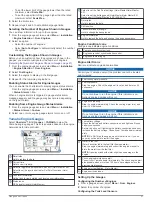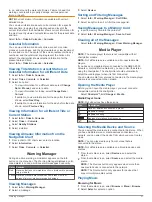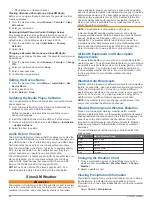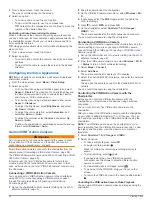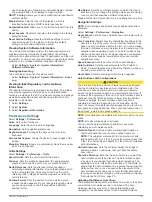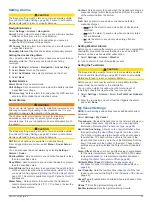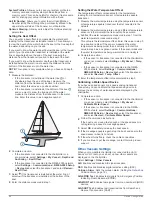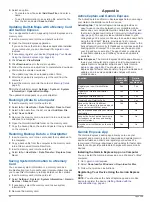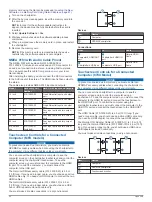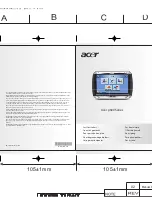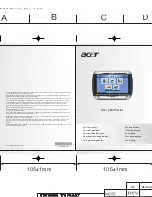
use this display as a stand-alone, individual display, instead
of grouping it with other displays to make a station.
GRID™ Pairing
: Allows you to pair a GRID remote input device
with this station.
Display Order
: Sets the order of the displays, which is
important when using a GRID remote input device.
Autopilot Enabled
: Allows you to control the autopilot from this
device.
Reset Layouts
: Resets the layouts in this station to the factory
default settings.
Reset Station Settings
: Resets all station settings to on all
connected devices in the station to the factory default
settings, and requires initial station setup.
Viewing System Software Information
You can view the software version, the basemap version, all
supplemental map information (if applicable), the software
version for an optional Garmin radar (if applicable), and the unit
ID number. You may need this information to update the system
software or to purchase additional map data information.
Select
Settings
>
System
>
System Information
>
Software Information
.
Viewing the Event Log
The event log shows a list of system events.
Select
Settings
>
System
>
System Information
>
Event
Log
.
Viewing E-label Regulatory and Compliance
Information
The label for this device is provided electronically. The e-label
may provide regulatory information, such as identification
numbers provided by the FCC or regional compliance markings,
as well as applicable product and licensing information. Not
available on all models.
1
Select
Settings
.
2
Select
System
.
3
Select
Regulatory Information
.
Preferences Settings
Select
Settings
>
Preferences
.
Units
: Sets units of measure.
Language
: Sets the on-screen text language.
Navigation
: Sets navigation preferences.
Keyboard Layout
: Arranges the keys on the on-screen
keyboard.
Screenshot Capture
: Allows the device to save images of the
screen.
Menu Bar Display
: Shows or automatically hides the menu bar
when it is not needed.
Units Settings
Select
Settings
>
Preferences
>
Units
.
System Units
: Sets the unit format for the device.
Variance
: Sets the magnetic declination, the angle between
magnetic north and true north, for your present location.
North Reference
: Sets the direction references used in
calculating heading information. True sets geographic north
as the north reference. Grid sets grid north as the north
reference (000º). Magnetic sets the magnetic north as the
north reference.
Position Format
: Sets the position format in which a given
location reading appears. Do not change this setting unless
you are using a map or chart that specifies a different
position format.
Map Datum
: Sets the coordinate system on which the map is
structured. Do not change this setting unless you are using a
map or chart that specifies a different map datum.
Time
: Sets the time format, time zone, and daylight saving time.
Navigation Settings
NOTE:
Some settings and options require additional charts or
hardware.
Select
Settings
>
Preferences
>
Navigation
.
Route Labels
: Sets the type of labels shown with route turns on
the map.
Turn Transition
: Adjusts how the chartplotter transitions to the
next turn or leg or the route. You can set the transition to be
based on time or distance before the turn. You can increase
the time or distance value to help improve the accuracy of the
autopilot when navigating a route or an Auto Guidance line
with many frequent turns or at higher speeds. For straighter
routes or slower speeds, lowering this value can improve
autopilot accuracy.
Speed Sources
: Sets the source for the speed readings.
Auto Guidance
: Sets the measurements for the Preferred
Depth, Vertical Clearance, and Shoreline Distance, when you
are using some premium maps.
Route Start
: Selects a starting point for route navigation.
Auto Guidance Path Configurations
CAUTION
The Preferred Depth and Vertical Clearance settings influence
how the chartplotter calculates an Auto Guidance path. If an
area has an unknown water depth or an unknown obstacle
height, the Auto Guidance path is not calculated in that area. If
an area at the beginning or the end of an Auto Guidance path is
shallower than the Preferred Depth or lower than the Vertical
Clearance settings, the Auto Guidance path may not be
calculated in that area, depending on the map data. On the
chart, the course through those areas appears as a gray line or
a magenta and gray striped line. When your boat enters one of
those areas, a warning message appears.
NOTE:
Auto Guidance is available with premium charts, in some
areas.
NOTE:
Not all settings apply to all maps.
You can set the parameters the chartplotter uses when
calculating an Auto Guidance path.
Preferred Depth
: Sets the minimum water depth, based on
chart depth data, that your boat can safely travel over.
NOTE:
The minimum water depth for the premium charts
(made before 2016) is 3 feet. If you enter a value of less than
3 feet, the charts only use depths of 3 feet for Auto Guidance
path calculations.
Vertical Clearance
: Sets the minimum height of a bridge or
obstacle, based on chart data, that your boat can safely
travel under.
Shoreline Distance
: Sets how close to the shore you want the
Auto Guidance path to be placed. The Auto Guidance path
may move if you change this setting while navigating. The
available values for this setting are relative, not absolute. To
ensure that the Auto Guidance line is placed the appropriate
distance from shore, you can assess the placement of the
Auto Guidance path using one or more familiar destinations
that require navigation through a narrow waterway (
).
Adjusting the Distance from Shore
The Shoreline Distance setting indicates how close to the shore
you want the Auto Guidance line to be placed. The Auto
Guidance line may move if you change this setting while
navigating. The available values for the Shoreline Distance
Device Configuration
61
Содержание GPSMAP 87 Series
Страница 1: ...GPSMAP 84XX 86XX 87XX Owner sManual...
Страница 85: ......
Страница 86: ...support garmin com GUID 25CCEC48 337E 47C0 8B89 5C35CCDB65AC v17 March 2021...

